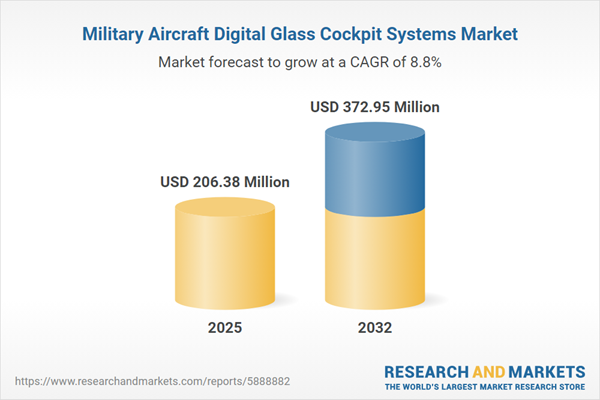Speak directly to the analyst to clarify any post sales queries you may have.
Senior defense leaders are leveraging the military aircraft digital glass cockpit systems market for operational advantage as modern air forces demand increased agility, situational awareness, and secure real-time data integration. These cutting-edge cockpit technologies are instrumental in enabling adaptability and readiness for mission-critical operations worldwide.
Market Snapshot: Military Aircraft Digital Glass Cockpit Systems
The global military aircraft digital glass cockpit systems market is experiencing robust momentum, valued at USD 189.44 million in 2024 and projected to reach USD 206.38 million in 2025. Industry forecasts anticipate this segment growing significantly, backed by an 8.83% CAGR through 2032 and an expected valuation of USD 372.95 million by the end of the forecast period. This growth signals a decisive transition from analog displays to enhanced digital solutions, focusing on collaborative mission management, technological innovation, and prompt assimilation across air defense sectors. Modernization is further expedited by investments in interoperability, adaptability, and advanced situational awareness to support increasingly complex mission requirements.
Scope & Segmentation
- Platform Types: Spanning single- and twin-engine fighters, multi-role helicopters for attack, utility, and transport, fixed- and rotary-wing transports, dedicated trainer aircraft, and unmanned aerial vehicles. Each class requires tailored integrations meeting distinct operational needs, which influence procurement and upgrade pathways.
- Installation Types: Catering to both new-build aircraft programs and retrofit solutions for legacy fleets. This enables incremental modernization while preserving the value of current aviation assets within defense organizations.
- End Users: Involving air force, army, and naval aviation units, as well as original equipment manufacturers and maintenance organizations. These stakeholders collaborate from specification to support, impacting technology diffusion and fleet reliability.
- Regional Coverage: Includes North America, South America, Europe, Middle East, Africa, and Asia Pacific. Distinct acquisition priorities shape each region’s adoption, with some prioritizing integration into new platforms and others focusing on phased upgrades to existing fleets.
- Companies Profiled: Key suppliers comprise Collins Aerospace Inc., Honeywell International Inc., Thales S.A., BAE Systems plc, L3Harris Technologies, Leonardo S.p.A., Safran S.A., Elbit Systems Ltd., Northrop Grumman Corporation, and Kongsberg Defence & Aerospace AS. Their emphasis on modular architecture supports adaptability for evolving military missions.
- Core Technologies: Features digital glass displays, modular avionics, advanced communications, next-generation sensor integration, embedded cybersecurity, real-time analytics, and augmented reality. These building blocks improve operational effectiveness and future-proof aviation assets for changing missions.
Key Takeaways for Senior Decision-Makers
- Cockpit systems designed for rapid reconfiguration support mission flexibility and responsiveness for varied operational demands.
- Adoption of open architecture streamlines future upgrades, aligning with new defense priorities and sustaining cost efficiency throughout the system lifecycle.
- Modern pilot interfaces help mitigate information overload and enhance situational awareness, contributing to safer missions and better decision quality during high-stress operations.
- Cockpit automation reduces crew workload by efficiently managing critical information, allowing timelier, more accurate responses in rapidly changing scenarios.
- Procurement strategies are increasingly informed by regional and operational context, balancing immediate enhancement with long-term asset resilience and security needs.
- Ongoing collaboration between military agencies and technology vendors underpins compliance and ensures fleets remain capable as mission requirements evolve.
Tariff Impact and Supply Chain Realignment
The introduction of U.S. tariffs on avionics imports is prompting digital glass cockpit system vendors to redesign supply chains for enhanced resilience. By forging relationships with local suppliers and establishing regional networks, providers ensure reliable delivery timelines for defense customers. This strategy helps military operators sustain operational readiness and mitigate disruptions amidst shifting geopolitical scenarios.
Methodology & Data Sources
Findings in this analysis are informed by interviews with defense procurement leads, aviation technology experts, and sector analysts. Additional validation incorporates regulatory assessments, technical documentation, and relevant whitepapers, ensuring the recommendations are actionable and reliable for strategic planning.
Why This Report Matters
- Empowers leadership to anticipate digital cockpit adoption patterns, supporting well-grounded procurement planning aligned with industry direction.
- Facilitates timely integration of advanced avionics while underscoring the importance of resilient, adaptive supply chains in the defense sector.
- Provides targeted insights for managing modernization risks and sustaining mission readiness in an evolving global security context.
Conclusion
Strategic alignment among defense leaders, system integrators, and technology providers is crucial for seamless integration of digital cockpits. Ongoing collaboration supports fleets that remain prepared to meet new mission and operational demands.
Additional Product Information:
- Purchase of this report includes 1 year online access with quarterly updates.
- This report can be updated on request. Please contact our Customer Experience team using the Ask a Question widget on our website.
Table of Contents
3. Executive Summary
4. Market Overview
7. Cumulative Impact of Artificial Intelligence 2025
Companies Mentioned
The companies profiled in this Military Aircraft Digital Glass Cockpit Systems market report include:- Collins Aerospace Inc.
- Honeywell International Inc.
- Thales S.A.
- BAE Systems PLC
- L3Harris Technologies, Inc.
- Leonardo S.p.A.
- Safran S.A.
- Elbit Systems Ltd.
- Northrop Grumman Corporation
- Kongsberg Defence & Aerospace AS
Table Information
| Report Attribute | Details |
|---|---|
| No. of Pages | 189 |
| Published | November 2025 |
| Forecast Period | 2025 - 2032 |
| Estimated Market Value ( USD | $ 206.38 Million |
| Forecasted Market Value ( USD | $ 372.95 Million |
| Compound Annual Growth Rate | 8.8% |
| Regions Covered | Global |
| No. of Companies Mentioned | 10 |









